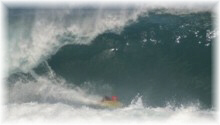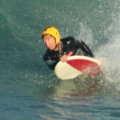 |
rodndtube.com's (OLD) MyPaipoBoards Forums. Reading but no posting on the OLD forums.
The (NEW) MyPaipoBoards Forums have moved to a new site. New registration is required.Click on the link below:
About the Forums - Read Me!
|
| View previous topic :: View next topic |
| Author |
Message |
bgreen

Joined: 20 Feb 2004
Posts:
Location: Qld. Oz
|
 Posted: Sun Apr 24, 2011 1:27 am Post subject: Posted: Sun Apr 24, 2011 1:27 am Post subject: |
 |
|
RNT808,
I'm intrigued regarding the inspiration for the design of your board - was it an idea you had or come from some other source. The bottom reminds me a bit of one of John Galera's paipo.
A fun looking board.
Bob |
|
| Back to top |
|
 |
RNT808
Joined: 11 Sep 2007
Posts:
Location: Makawao Maui
|
 Posted: Sun Apr 24, 2011 2:42 pm Post subject: Posted: Sun Apr 24, 2011 2:42 pm Post subject: |
 |
|
Bob,
It would be great (for my ego) to say that I came up with the design of this board all by myself. But that wouldn’t be true and it wouldn’t give credit to paipo builders whose ideas and concepts influenced my thought process. And seeing how I got most of those ideas from reading the interviews and member posts on this site would like to thank you and Rod for making this valuable resource available to the rest of us.
Two interviews that had a lot impact were Paul Lindbergh’s and Paul Gross’s. I was very interested in Paul Lindbergh’s ideas about lift and speed in regards to the shape of his HPD. And some of that went into this design. Although Paul Gross seems to work primarily with foam, his ideas about rocker and wide point placement and their effect on turn line length have been influential with me for a while now. The same is true of Tom Wegener’s ideas about bottom shape, especially in regards to his Bluegill Alaia. John Galera’s construction methods influenced the way I built this board as well, hence the similarities. So as you can see I just pickup ideas and sort of incorporate them into what I’m thinking about at the moment.
The way I look at it nothing is really new. A lot of talented people have been making paipos over the years and I can’t imagine that if I think of something someone else hasn’t thought of it first. I look at it as a collaboration between me and those how came before. |
|
| Back to top |
|
 |
bgreen

Joined: 20 Feb 2004
Posts:
Location: Qld. Oz
|
 Posted: Sun Apr 24, 2011 3:40 pm Post subject: Posted: Sun Apr 24, 2011 3:40 pm Post subject: |
 |
|
RNT808,
To come up with a good looking and performing board based on the interviews is still no mean feat, especially if it is a combination of different ideas.
It's always pleasing to read not just that people enjoy the interviews but that it has inspired them to do something, regardless of whether it is to make a particular design, ride a paipo in a certain way or to engage with paipo in a different way.
Bob |
|
| Back to top |
|
 |
kid

Joined: 11 Jan 2010
Posts:
Location: Bells Beach
|
 Posted: Tue Apr 26, 2011 4:19 am Post subject: Posted: Tue Apr 26, 2011 4:19 am Post subject: |
 |
|
Hey Guys, sorry about my slow responses, my interweb connection is bloody terrible at my new place!
Anyway, I got to test the flex paipo in the exact type of surf I designed it for. It was super clean 3-4ft, not all that hollow, but nice big walls. The board performed brilliantly! Being big and wide, I expected it to be fast, but it was DAMN fast!
The really surprising thing was just how much the flex worked. I found that I could hang it deep and high, almost tucking myself under the crumbling lip. It never felt like letting go or sideslipping as long as I held that outer rail up. As I shot through the section I found that releasing the rail, and allowing the board to flatten back out, would cause it to almost slingshot out onto the shoulder.
The other unexpected thing was how well the flex would allow the board to cutback. It would bite and carve into a deep rail turn, and I could feel the bottom of the board bending across the tail.
On my flip-nose paipo, I found that the flexiness of the board would sometimes make it almost wobble and stall in bumpy high speed conditions. The rib around this board made it fairly stiff front to back, but with a nice lateral flex across the back end. It was flexy enough to help on take-offs, but never once had that spongy slow stalling feel.
I'm really happy with this board, and surprised how well such a simple design could work! This wouldn't be my chosen board in steep hollow conditions, as the keel-fin spoon board performs flawlessly in those types of waves. But when its mid to big, and a bit fat and slow, this board is the bomb!
_________________
"It's not a beer-belly, it's a displacement hull"
www.deluxepaipo.com |
|
| Back to top |
|
 |
bgreen

Joined: 20 Feb 2004
Posts:
Location: Qld. Oz
|
 Posted: Tue Apr 26, 2011 4:25 am Post subject: Posted: Tue Apr 26, 2011 4:25 am Post subject: |
 |
|
BJ,
What's involved in "holding the outer rail up"? Do you mean you are levering it up so the inside rail bites more or something more subtle? The superman arm is reported to achieve greater pressure on the inside rail.
Bob |
|
| Back to top |
|
 |
kid

Joined: 11 Jan 2010
Posts:
Location: Bells Beach
|
 Posted: Tue Apr 26, 2011 5:31 am Post subject: Posted: Tue Apr 26, 2011 5:31 am Post subject: |
 |
|
Hey Bob,
In the superman position, I use my torso to weight the inside edge, as you said. The other hand, on the outside, is used to grip the rail. By pulling the outside edge up or relaxing it, I'm able to change the bottom contour of the board.
Pulling up puts roll into the bottom of the board, helping it to hang higher in the face of the wave. Releasing it flattens the board out, causing it to accelerate dramatically.
I'd also like to echo RNT808's sentiments and say that the interview section of this site is probably the most detailed and useful resource on surfboard design on the planet. Swaylocks is good, but most stand-up design falls into one of a few tried and tested designs. Paipo and bellyboard design is so incredibly diverse, and so personal to the individual, that the possibilities are almost endless. I've made 30 or so paipo's, and every one was based on a design or principle that I read about in the interviews on this site.
For anyone new on here, put aside a few nights with no tv, put a six-pack in the fridge, and read (and re-read) the entire interview catalogue! You'll never see board design or surfing through the same eyes again!!!!
_________________
"It's not a beer-belly, it's a displacement hull"
www.deluxepaipo.com |
|
| Back to top |
|
 |
bgreen

Joined: 20 Feb 2004
Posts:
Location: Qld. Oz
|
 Posted: Tue Apr 26, 2011 6:00 am Post subject: Posted: Tue Apr 26, 2011 6:00 am Post subject: |
 |
|
Hello BJ,
Thanks for the explanation and positive comments. My favourite feedback is that the interviews are "a combination of manic obsession and lunatic journalism" - http://kurungabaa.net/2010/10/08/bellyboardingpaipo-research-and-history/
I think it's great you are trying the various designs. There is a challenge coming up though - a board based on a woman's body and which has handlebars. I'm looking for someone to do a drawing based on the interview specifications.
I see you must have had some great conditions for testing the board. Love to get back down your way again.
regards
Bob |
|
| Back to top |
|
 |
ted

Joined: 14 Jan 2008
Posts:
Location: Hawaii, Big Island
|
 Posted: Thu Apr 28, 2011 1:28 am Post subject: Posted: Thu Apr 28, 2011 1:28 am Post subject: |
 |
|
Paul Lindberg built a flex HPD which allows a variable rolled bottom profile.
Flat:

Flexed:
 |
|
| Back to top |
|
 |
|
|
You cannot post new topics in this forum
You cannot reply to topics in this forum
You cannot edit your posts in this forum
You cannot delete your posts in this forum
You cannot vote in polls in this forum
|
|

